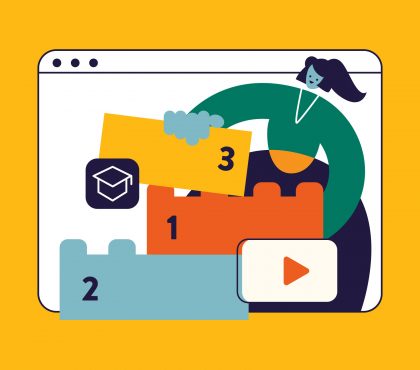When the Coronavirus pandemic struck, businesses around the world had to send employees to work remotely. However, the needs for training are still visible. Corporate workers always require new knowledge or skills to improve their performance. With legacy methods no longer effective and attention spans shortening, microlearning for employee training emerges as a viable solution.
The modern way of life has shrunk people’s available time. Long training courses are no longer effective. They gradually become irrelevant, time-consuming, and overall counter-productive. On the flip side of the coin, microlearning enables employees to achieve only one specific learning objective in a much shorter span. Corporate learners can quickly fill their knowledge gaps and upscale their proficiency.
If you’re investing in microlearning videos for your business, here’s some information that you should not skip. Learn about microlearning’s benefits, possible obstacles, and how to create cost-effective microlearning training courses to improve online training quality.
- What Is Microlearning?
- 5 Benefits of Microlearning in Business:
- Common Obstacles When Creating Microlearning For Employee Training
- 3. Lacking Practical Application
- 4. Letting The Clock Limit Your Content
- 5. Sticking To One Delivery Format
- 6. Mis-repurposing Existing Training Resources
- 8 Best Practices To Make Effective Microlearning Training Content
- 3 Best Examples Of Microlearning
- Conclusion
What Is Microlearning?
To put it simply, microlearning uses text, video, ebook, interactive multimedia, and other materials to deliver skill-based learning and education in bite-sized sections. Microlearning for employee training is always short, averaging between five to ten minutes only. Microlearning is generally used in the corporate environment because it helps employees learn quickly while performing their jobs.
5 Benefits of Microlearning in Business:
- Enhange Knowledge Retetion
- Facilitate Easy Mobile Training
- Rapidly Bridge Performance Gaps
- Allow A More Cost-effecient Solution to Online Training
Preparation Checklist to Power your Digital Transformation
Wondering if you miss anything in your preparation to digitize your training? This is just what you need.
1. Enhance Knowledge Retention
Microlearning provides small segments of information, which enables the mind to process more effectively. Employees receive the exact knowledge they need, thus, eliminating redundancies. Corporate learners will be able to absorb and retain the information before moving on to the next training activity or module.
2. Facilitate Easy Mobile Training
Each microlearning video takes only minutes. This allows corporate learners to participate in brief modules or units during their little spare time. It optimizes the learning proficiency by incorporating “studying on the go”.
3. Rapidly Bridge Performance Gaps
Microlearning videos focus on one key task, skill, or concept at a time. This allows corporate learners to quickly fill their performance gaps. They can target specific areas of improvement instead of having to sit through a lengthy and irrelevant online training session.
4. Allow A More Cost-efficient Solution To Online Training
Microlearning offers Digital Learning Managers a chance to create high-quality eLearning scenarios, online presentations, or tutorials on budget. These only costs a fraction of producing a full-fledged online training course. Microlearning content is also more condensed and concise. It does not require as much instructional design or development time, which is always a major plus.
5. Boost Morale And Motivate Corporate Learners
Microlearning fulfills instant gratification. When employees can complete the training content and acquire the skills or information they need, it increases their motivation. This prompts corporate learners to seek out other microlearning activities.
Example Microlearning Video:
Cost of Equity – Accounting Animation by F.Learning Studio
Common Obstacles When Creating Microlearning For Employee Training
Being short and condensed doesn’t mean creating effective microlearning content isn’t challenging. There are as many obstacles to it as with legacy methods.
Here are the common roadblocks you may find along the way:
- Overloading Information
- Not Knowing When To Use Microlearning
- Lacking Practical Application
- Letting The Clock Limit Your Content
- Sticking To One Delivery Format
- Mis-repurposing Existing Training Resources
1. Overloading Information
Microlearning is all about focusing on a single piece of information only. If you cram too much information into the content, it will turn into a full-fledged meal instead of bite-size bits of knowledge. To avoid flooding your courses with irrelevant knowledge, condense the subject matter down to the basics. Each microlearning resource should only focus on one key learning objective.
Don’t try to cover too much ground with your microlearning videos. If you do find the need to include additional stats, facts, or ideas, create multiple separate microlearning videos instead of one. Each of which should focus on individual sub-topics or skills that you think your employees must acquire. This also prevents cognitive overload and improves memory retention, the primary benefits of using microlearning for employee training.
2. Not Knowing When To Use Microlearning
Microlearning isn’t the end-all-be-all method to online training. These are certain scenarios where you should not use microlearning.
Below are four occasions where microlearning will not be as effective:
- Use Microlearning To Follow The Trend
Microlearning is indeed one of the most popular learning strategies as of late. But others using it doesn’t mean that you must use it also. Microlearning only works when it is implemented correctly in necessary situations.
- Use Microlearning To Explain Complex Concepts
Microlearning isn’t the best format to deliver highly technical and complex concepts to your employees. It’s simply too short to cover long and complicated knowledge. You can’t expect your learners to become experts after going through just a standalone 10-minute microlearning video. When you chunk a topic that requires continuous flow and teaches it in intervals, it would not make any sense.
- Use Microlearning To Master A Subject
Certain things just cannot be learned fast. Studying to become an exceptional manager or charismatic salesperson takes much more than a few minutes. Microlearning only gives you enough information to perform well to a fixed extent, but not enough to become a master.
- Use Microlearning To Replace eLearning
Microlearning is only a temporary solution to quickly remedy a problem with immediate information. However, it may also hide a larger knowledge gap. That is why you cannot replace other eLearning materials with macro learning entirely. It’s best to use microlearning as a supplement to already learned knowledge.
3. Lacking Practical Application
The main purpose of training is to help corporate learners apply the information they learn in real-world settings. When you’re creating a microlearning course, place the knowledge into a practical context. This presents a real value to the content with clear simulations, branching scenarios, and examples. Focus on what you want your employees to gain and use from each microlearning online training resource.
4. Letting The Clock Limit Your Content
Yes, microlearning should be brief, focused, and to the point. However, you should not allow the time limit to be your only concern. There are other things to worry about, too. For example, think of the scope of the microlearning course. How much information is sufficient for your corporate learners to complete the task or improve their understanding? The main point here is to always provide the essentials they require as quickly as possible.
5. Sticking To One Delivery Format
The delivery is just as important as your content itself. A clear delivery makes the information easy to digest and comprehend. Microlearning should include a good mix of materials to diversify how you convey the knowledge. Different learners have different requirements and needs which translates into different learning preferences. Using diverse materials and formats allow you to cater to those differences, leading to a more effective learning experience.
6. Mis-repurposing Existing Training Resources
At the time of transiting to online training, you may have already developed a library worth of content. Hence, a logical step to take is to recycle the existing materials to create new microlearning resources. However, most Digital Learning Managers struggle to determine what to and what not to repurpose. They end up adding way too much or too little information.
To effectively repurpose old materials into useful microlearning resources, you must evaluate the existing content and narrow down the objectives, core information, and goals. Then, spice up the highlighted information with fresh images, templates, and other media formats.
8 Best Practices To Make Effective Microlearning Training Content
To create effective and useful microlearning courses, you must:
- Stay Focused
- Use Microlearning Appropriately
- Know Your Audience
- Incorporate Elements Of Experiential Learning
- Recycle Old Content Responsively
- Diversify Delivery Formats
- Use Active Voice And Conversational Tone
- Partner Up
1. Stay Focused
To prevent cognitive overload, your microlearning resources should focus on a single subject each. Filter through the information to determine what’s useful to your employees and avoid covering too much ground. Stick to one topic at a time then provide links for related content. This allows corporate learners to explore sub-topics and access articles as well as other online resources at their disposal.
2. Use Microlearning Appropriately
Consider the type of content and your audience to decide which learning method to use. If the matter requires quick information to address immediately, opt for microlearning. However, not all microlearning for employee training videos follows the same format. You can present your content in different ways that prove the most appropriate.
Available types of microlearning for your consideration are:
- Interactive parallax-based scrolling
- Videos
- Infographics
- Static resources
- Simulations
- Branching scenarios
- Podcasts
- Gamification
- Social media
- Geofencing
- Performance Support Tools (PSTs) or job aids
3. Know Your Audience
Understanding your target audience is the best way to plan effective and useful training materials. By determining learners’ current level of skills as well as the existing knowledge gaps, you can provide exactly what they want to learn. That’s what makes microlearning so effective. Your employees can skip the noise and engage in training effortlessly.
4. Incorporate Elements Of Experiential Learning
Using real-world examples in your microlearning materials will help learners relate to the content. It facilitates more effective knowledge retention through actual scenarios and experiences in your storyboards. However, be careful not to go into too much detail in the examples. Keep it simple and short to avoid unintended distractions from the main concepts.
5. Recycle Old Content Effectively
Don’t let the old materials that you spend hundreds of hours creating go to waste. Instead, divide them into small bite-sized chunks for microlearning. But don’t get too greedy and stuff all the information you can find into a single video. Skip the lengthy intro, drop the fluff, and jump straight to what your audience demands.
Learn how to effectively repurpose existing content for microlearning.
6. Diversify Delivery Formats
Incorporating different multimedia elements such as videos, infographics, and animation is an effective way of improving knowledge retention. You can use animation to create a strong impression on the learner’s mind and audio narration to ensure the retention of information. If you want to use videos, provide learners with the control so that they can pause, rewind and play the video at their convenience.
Interactive courses are also very effective for microlearning. They allow corporate learners to actively take part in the training process. Simulations, interactive motions, games, etc, help employees practice their attained knowledge and retain information.
7. Use Active Voice And Conversational Tone
An effective microlearning for employee training storyboard should always be in an active voice. It keeps the content clear, simple, and focused. Try to avoid narratives or passive sentences as much as possible. The tone should be conversational to help learners relate to your video.
8. Partner Up
Even with all of the insider’s know-how provided here, making your microlearning materials will still be a daunting task. No one is an immediate expert at anything. It takes years of practicing, of trials and errors to produce training videos that your employees want to watch again and again.
But why trouble yourself when you can partner up with a trusted provider and have them do it for you? Save your time and effort for other strategic tasks that only you can perform. Leave the microlearning videos for the professionals like F.Learning Studio.
Being the creator of many successful eLearning courses and microlearning videos, F.Learning Studio understands your worries and struggles. Let us share the burden on your shoulder and help your business grow!
If you’re interested in learning more about F.Learning Studio’s services, feel free to contact us right now!
3 Best Examples Of Microlearning
Let’s take a look at the following three examples of effective microlearning videos.
1. One QBE – Animated Training Videos
One QBE is an international corporation that employs over 14,500 employees in 37 different countries. They wanted to develop consistent internal training materials that employees can easily access from various locations around the world. With their request in mind, F.Learning Studio incorporated animation to create consistent training content for One QBE’s global staff. We helped them meet the demands of the mobile workforce and bridge the knowledge gap among all 14,500 employees.
2. Aviassist Drone Training – Explainer Video for Corporate
Aviassist set out on a mission to provide aviation expertise to Australian businesses who are trying to use drones. The company contacted F.Learning Studio to collaborate on an animated video discussing the no-fly zones in Australia. We illustrated the details of heights and dangerous situations with clear and vivid motions. This helped learners to visualize the altitude, length, or different safe areas to operate drones.
3. Sole Trader Business Example – Business Laws Animation
Law courses are full of abstract knowledge. They can be heavy, intensive, sometimes even dull, and boring. F.Learning Studio decided to change the delivery, adding animation with visual metaphors to make the theories less intimidating. We also incorporated the knowledge into daily situations to demonstrate how it should be applied in real life.
Conclusion
Microlearning for employee training is only effective when used in an engaging package that fills immediate knowledge gaps. It’s not the sole answer to all of your training problems. But when microlearning training is delivered consistently, businesses can drive continuous learning, improves knowledge retention, and inspire long-term behavior change.
Want to see the same in your organization, contact F.Learning Studio for a free consultation call right away!
You May Also Like:
- How Much Does A Corporate Training Video Cost?
- L&D Tools Part 4: Best Microlearning Platforms of the year 2022

Sean Bui, the founder and creative director of F.Learning Studio, is a respected leader in the e-learning and multimedia production industry. With over 10 years of experience, he has dedicated his career to helping organizations create engaging and impactful learning experiences.
Under his leadership, F.Learning Studio has grown into a trusted partner for organizations in the education, healthcare, and corporate training sectors, producing over 2,000 minutes of educational animation.




